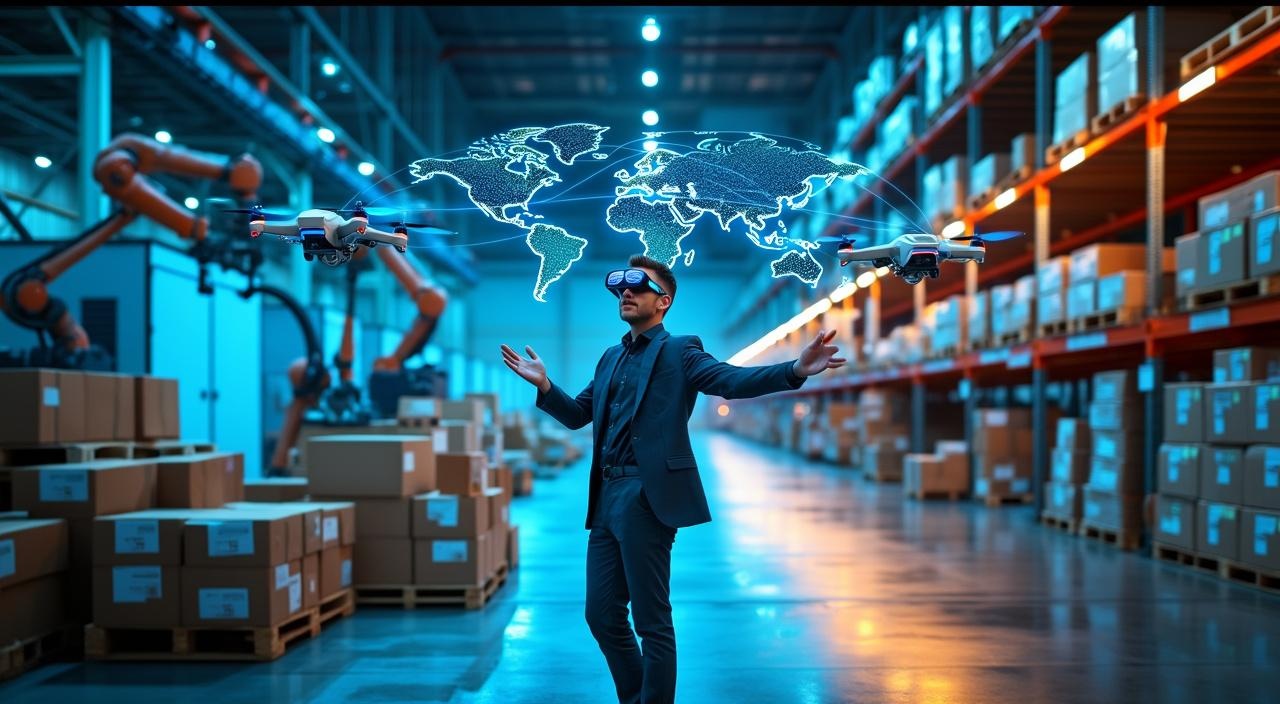The global AI revolution redefines economic boundaries, unleashing unprecedented connectivity and transformative potential across industries. Businesses aren’t just adopting AI—they’re strategically integrating intelligent technologies that will add a staggering $15.7 trillion to the global economy by 2030, completely changing how value is created and distributed.
Key Takeaways:
- AI investments are surging, with 78% of organizations actively implementing artificial intelligence technologies by 2025
- Cross-border communication and commerce are being dramatically simplified through advanced AI translation capabilities
- Supply chain operations are being revolutionized by predictive analytics and real-time adaptive systems
- Productivity gains are accelerating, with AI-powered companies entering markets 25% faster than traditional competitors
- Strategic AI integration is becoming a critical competitive advantage for businesses across all sectors
The AI-Powered Global Connectivity Explosion
Companies aren’t just adopting AI—they’re reshaping the entire global economy through artificial intelligence. I’ve watched this transformation accelerate beyond anyone’s wildest predictions.
The numbers tell a compelling story. By 2025, 78% of organizations will be using AI actively. Even more striking? 83% of companies are prioritizing AI investments right now, treating it as their primary growth engine rather than a nice-to-have technology.
Economic Impact at Scale
Here’s what catches my attention most: AI is projected to contribute $15.7 trillion to the global economy by 2030. That’s not just growth—it’s a complete restructuring of how value gets created and distributed across borders.
The human element remains central to this shift. Currently, 66% of the global population engages with AI workflows daily, often without realizing it. From supply chain optimization to real-time translation services, AI is breaking down traditional barriers that once limited global commerce.
This connectivity explosion isn’t happening in isolation. As I’ve explored in my analysis of how AI Agents Won’t Replace You—But They Might Change What It Means to Be You, we’re witnessing a fundamental shift in human-AI collaboration patterns.
Breaking Language Barriers: Communication Without Boundaries
Language barriers cost businesses millions in lost opportunities every year. I’ve watched companies struggle with international expansion, hiring expensive translators or missing deals entirely because of communication gaps.
AI translation technology has changed this landscape dramatically. AI Agents Won’t Replace You—But They Might Change What It Means to Be You explains how these tools reshape professional identities rather than eliminate them.
The Technology Stack Powering Global Communication
Today’s AI translation platforms deliver unprecedented accuracy and speed. DeepL excels at nuanced European language pairs, often outperforming human translators in technical contexts. Google Translate covers 130+ languages with real-time camera integration. ChatGPT provides contextual translations that understand cultural subtleties and business terminology.
These aren’t your grandfather’s translation tools. They understand context, cultural references, and industry-specific jargon with remarkable precision.
Real-World Impact on Business Operations
The numbers tell a compelling story. According to business expansion data, 70% of global leaders are planning international expansion within the next two years. They’re counting on AI-powered translation to make it happen.
Real-time cross-border interaction now happens seamlessly. Customer support teams handle inquiries in dozens of languages without hiring multilingual staff. Product localization that once took months now happens in days. Transform Your Appointment-Based Business with AI shows how even small businesses can compete globally using these technologies.
Natural language processing has matured beyond simple word substitution. It now captures meaning, tone, and cultural context. Cross-cultural collaboration happens without the friction that once slowed international partnerships.
The barriers are falling. The question isn’t whether AI translation will change how we do business internationally—it’s how quickly you’ll adapt to the new reality.
Transforming Business Operations: AI-Driven Supply Chain Revolution
I’ve witnessed firsthand how predictive analytics is reshaping how businesses operate globally. The numbers tell a compelling story: 33% of data center capacity is now dedicated to AI processing, powering supply chain transformations across industries.
The adoption rate speaks volumes. 72% of companies in retail, manufacturing, and healthcare have integrated AI into their supply chains. These aren’t just experimental projects anymore. They’re core business operations.
Real-World Applications Changing the Game
Dynamic pricing has revolutionized how companies respond to market fluctuations. I’ve seen retailers adjust prices thousands of times per day based on demand patterns, competitor actions, and inventory levels. Automated fulfillment systems now predict what customers want before they click “buy.”
Amazon’s anticipatory shipping patents this approach perfectly. The company moves products closer to customers based on predictive algorithms, reducing delivery times from days to hours. Microsoft’s Azure AI helps manufacturers predict equipment failures weeks in advance, preventing costly downtime. Alibaba’s smart logistics network processes millions of packages daily with minimal human intervention.
The supply chain innovation extends beyond individual companies. Global logistics networks now share real-time data, creating interconnected systems that adapt instantly to disruptions. When a port faces delays, AI automatically reroutes shipments through alternative channels.
These changes aren’t just about efficiency. They’re fundamentally altering competitive dynamics. Companies that master predictive analytics gain substantial advantages in:
- Cost reduction
- Customer satisfaction
- Market responsiveness
The question isn’t whether to adopt these technologies—it’s how quickly you can implement them before competitors do.
This transformation represents the largest shift in business operations since the advent of computerization itself.

Economic Implications: The $15.7 Trillion AI Opportunity
The numbers don’t lie. AI isn’t just changing how we work—it’s rewriting the entire economic playbook with a projected $15.7 trillion impact by 2030.
I’ve watched countless businesses struggle with market entry timing. Here’s what changed everything: AI-driven companies now enter markets 25% faster than traditional competitors. That’s not incremental improvement. That’s a complete competitive reset.
The telecommunications sector alone presents a staggering $4.7 trillion opportunity. Companies investing in AI infrastructure aren’t just upgrading their systems—they’re positioning themselves at the center of a massive economic shift. AI Revolution: Entrepreneurs’ Survival Kit for the New Business Battleground explores how smart leaders are capitalizing on this transformation.
Cross-Border Commerce Gets an AI Boost
Digital commerce barriers are crumbling faster than anyone predicted. AI-powered translation, automated compliance checking, and predictive logistics are making international trade accessible to businesses that couldn’t afford global expansion before.
The Productivity Paradox Solved
Remember when productivity gains seemed to plateau? AI just shattered that ceiling. Companies implementing AI automation report productivity increases that would have been impossible with traditional methods alone.
The Federal Reserve’s latest analysis confirms what I’ve been telling my clients: we’re not just seeing isolated improvements—we’re witnessing systematic economic integration across industries. AI Automation Revolutionizes Small Biz: Unlock Efficiency & Growth Today! breaks down exactly how smaller businesses can capture their share of this opportunity.
The question isn’t whether AI will reshape our economy. It already has. The question is whether your business will be part of the $15.7 trillion opportunity or watch from the sidelines.
Future-Proofing Business: Strategic AI Imperatives
Digital transformation is getting a massive AI makeover. 80% of digital transformation will be powered by AI by 2025. That’s not a prediction anymore—it’s happening right now.
I’ve seen companies scramble when they realize their competitors have AI-powered customer service running circles around them. You don’t want to be that company.
Three Strategic Moves You Can’t Ignore
Smart businesses are making these moves today:
- Invest in multilingual AI solutions – Global markets demand global communication
- Strengthen data privacy frameworks – Customers won’t trust sloppy data handling
- Prepare infrastructure for exponential connectivity demands – Your systems need to handle the surge
The companies winning this race aren’t necessarily the biggest. They’re the ones who understand that AI creates competitive advantage through smart implementation, not just adoption.
Your digital strategy needs AI integration now. Waiting means watching your market share disappear.

Real-World AI Transformation Examples
The numbers don’t lie. Amazon and Microsoft combined have poured over $80 billion into AI infrastructure investments, fundamentally reshaping how we think about computing power and accessibility.
Industry Leaders Setting the Pace
Here’s what’s happening across sectors right now:
- Tech giants are building AI-first networks through the AI-RAN Alliance, creating smarter telecommunications infrastructure
- Healthcare facilities show 90% adoption rates for AI-powered diagnostic tools, cutting diagnosis time from hours to minutes
- Manufacturing plants reduce downtime by 30% using predictive maintenance algorithms
I’ve watched this transformation firsthand while consulting with businesses making the leap. The companies investing now aren’t just buying technology—they’re purchasing competitive advantage.
Strange but true: The same AI systems helping doctors spot cancer earlier are optimizing supply chains and predicting market trends. This convergence across industries proves we’re witnessing something bigger than isolated tech upgrades.
Smart entrepreneurs are already harnessing these innovations to build more efficient operations.

Sources:
• Telcon News – AI Spending Soars as Network Investment Lags in Global Expansion
• Coherent Solutions – AI Adoption Trends You Should Not Miss 2025
• Bernard Marr – Mind-Blowing AI Statistics Everyone Must Know About Now in 2025
• The Network Installers – AI Data Center Statistics
• RBC Wealth Management – AI’s Big Leaps in 2025








